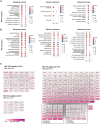Transcriptome Analysis of Monocytes Treated With Dengue Virus Nonstructural Protein 1 Revealed a Shift in Transcripts Involved in Self-Propagated Proinflammation and Antiviral Responses
- PMID: 40166903
- PMCID: PMC12247844
- DOI: 10.1093/infdis/jiaf166
Transcriptome Analysis of Monocytes Treated With Dengue Virus Nonstructural Protein 1 Revealed a Shift in Transcripts Involved in Self-Propagated Proinflammation and Antiviral Responses
Abstract
Nonstructural protein 1 (NS1) of dengue virus (DENV) can influence dengue severity. In this study, we used RNA sequencing analysis to assess the blood monocyte response to different concentrations of NS1. We showed that NS1 at the level found in severe dengue may be involved in severe dengue development through 2 potential mechanisms: induction of excessive inflammation and suppression of antiviral responses. At high levels, NS1 significantly up-regulated S100A8 and S100A9, ACOD1, and TREM1, which might help amplify the inflammatory loops. In terms of antiviral suppression, we found that high NS1 concentration significantly suppressed interferon signaling and major histocompatibililty complex class II transcripts. This potentially delayed the clearance of both DENV and NS1 protein. Our study highlighted the possible role of NS1-activated monocytes in dengue severity.
Keywords: Dengue virus; monocyte; nonstructural protein 1; transcriptome analysis.
© The Author(s) 2025. Published by Oxford University Press on behalf of Infectious Diseases Society of America.
Conflict of interest statement
Potential conflicts of interest. All authors: No reported conflicts. All authors have submitted the ICMJE Form for Disclosure of Potential Conflicts of Interest. Conflicts that the editors consider relevant to the content of the manuscript have been disclosed.
Figures







References
-
- Saxena SK, Kumar S, Maurya VK. The global distribution and burden of dengue and Japanese encephalitis co-infection in acute encephalitis syndrome. In: Rodriguez-Morales AJ, eds. Current topics in neglected tropical diseases. Rijeka, Croatia: IntechOpen, 2019:1–10.
-
- Guzman MG, Harris E. Dengue. Lancet 2015; 385:453–65. - PubMed
MeSH terms
Substances
Grants and funding
LinkOut - more resources
Full Text Sources
Medical
Research Materials
Miscellaneous

